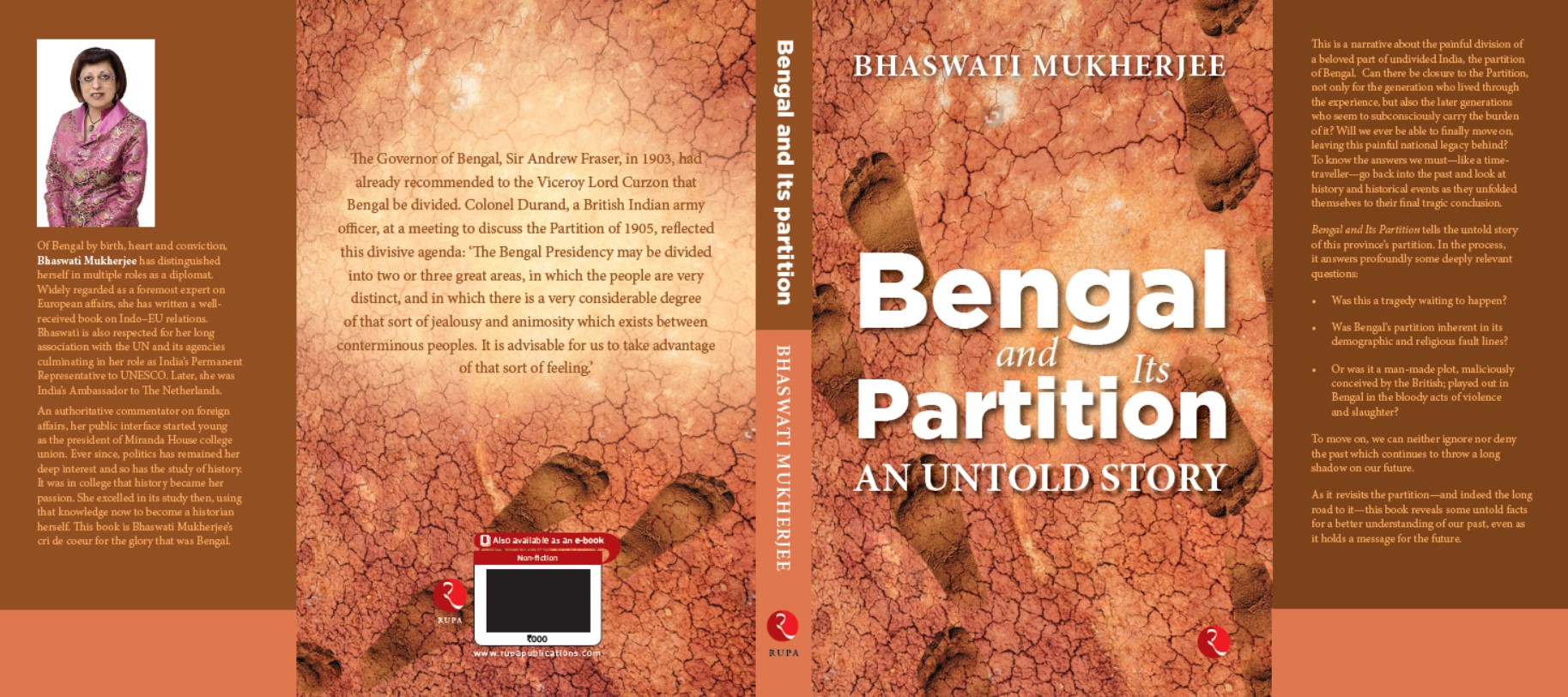Book Title: Bengal and its Partition: An Untold Story
Author: Bhaswati Mukherjee
Publisher: Rupa Publications India Pvt Ltd
Pages: 213 in hard cover
Price: Rs. 595/-
Partitioning a Process of British Perfidy
Writing about India’s partition and many other related issues/events of those times as well as of periods well before and well after Independence is not very easy because of so much of history being swept under the carpet, destroyed, kept classified, or twisted. And while the partition of India’s Western part was written about, the partition of the Eastern India, i.e. Bengal, was not much written about, even though much that happened then continues to affect India and Bangladesh in many ways. The author deserves credit for taking on the subject and making a good narration of it.
The long story of both undivided and divided Bengal is a series of tragedies. Common to the entry of both the Mughals and the British was suppression looting. The Mughals grabbed resources, richer land i.e., Eastern Bengal and of course, converted. The British, through a small group named the East India Company (EIC) looted and looted, sending much of the loot back home. Next two tragedies were the famines of 1770 and 1943. Then came the two partitions of Bengal-1905 and 1947. And after second partition, Bengali East Pakistan got ruled, or rather, misruled, by Punjabi-dominated West Pakistan and eventually suffered such brutal suppression that led to East Pakistanis rebelling and finally liberating themselves with substantial Indian support.
The Battle of Palashi, or Polashi in Bengali and corrupted by the British to Plassey, fought on 23 June 1757 resulted in victory for the EIC and marked the start of nearly two centuries of British rule in India. Robert Clive bribed Mir Jafar, the military head of the Siraj-ud-Daula’s army and other key persons of the army and conspired with the bankers and merchants of Bengal. Between Clive, also described as an “unstable sociopath” and the EIC, the huge plunder of Bengal continued till the Battle of Buxar in 1764. The EIC was a band of master thugs, merciless, with no qualms and limitless greed. However, in Clive’s case, as the book reveals, he rose from EIC’s clerk earning 5 Pounds Sterling to a Baron, but killed himself when he was 49 years old.
Since 1765, following the Battle of Buxar, the province of Bengal, which included present-day West Bengal, Bihar, Odisha, Bangladesh and Assam came under the British, with Calcutta as the capital of the province and also of British India. But it was too large an area which made it difficult to administer. In 1874, Assam was sliced away from Bengal. Initially, Lord Curzon proposed the partitioning of the province as an administrative measure but later, the idea occurred of using the Bengal partition as a political tool to undermine the growing nationalism in Bengal and other parts of India.
A list of the book’s chapters gives a very good idea of all the relevant developments and issues covered, in particular, of the utter perfidy of the British, which succeeded brilliantly owing to politics, greed and gullibility of some of the Indian leaders, both Muslim and Hindu. The chapters are: Bengal Encounters Islam, Plassey: Sale of Bengal, 1857: Impact on the Colonial Narrative, Indian Renaissance: India Rediscovers her Soul, Hindu Nationalism versus Fundamentalist Islam, A Struggle for Identity: Language versus Religion, Partition Politics: Rise of Muslim Communalism, An Ugly Colonial Plot: The Communal Award of 1032, Unfolding the Separatist Agenda, Genocide and Colonial Politics: The great Bengal Famine, Great Calcutta Killings, Noakhali and Gandhi: The Beginning of the End, Was Partition Inevitable? and Epilogue.
Over these chapters, the book throws the lid off a can of worms on many aspects of the British deceit, combined with their “imperial arrogance” as the author puts it. Many of their actions and statements are the kind which would make good Indians’ blood boil.
In an environment of Hindu-Muslim amity as had developed in Bengal based on Bengali language and cultural roots, they connived against the interests of Hindus/encouraging the Muslim League to separate.
The Governor of Bengal, Sir Andrew Fraser, in 1903, had already recommended to the Viceroy Lord Curzon that Bengal be divided. Colonel Durand, a British Indian army officer, at a meeting to discuss the Partition of 1905, reflected this divisive agenda: ‘The Bengal Presidency may be divided into two or three great areas, in which the people are very distinct, and in which there is a very considerable degree of that sort of jealousy and animosity which exists between conterminous peoples. It is advisable for us to take advantage of that sort of feeling.’
A major war-winning factor for the British and the Allies in World War (WW) I was 1.5 million Indian Army troops. In WW II, it was not enough that 2.5 million Indian Armed Forces personnel fought in that war and again won it for the Allies, India, particularly Bengal, had bear a famine as food grains were sent for feeding the British Army at the cost of 3 million Indians starving to death. Prime Minister Winston Churchill is quoted in the book saying, “I hate Indians. They are a beastly people with a beastly religion. The famine was their own fault for breeding like rabbits.”
The book’s timing with 50 years of Bangladesh’s liberation is also a reminder that the British aim of partitioning Eastern India at least, failed within 24 years.
This book should be read by all Indians, British historians, Bangladeshis and also by those inimical to India.

The writer is editor WordSword Features. He is also a strategic analyst and former spokesperson, Defence Ministry and Indian Army, and can be contacted at wordsword02@gmail.











